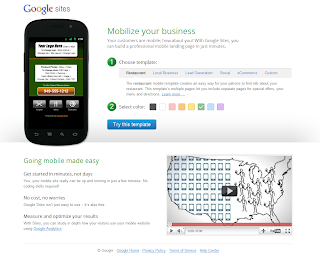By the end of this year, it is predicted that over half of all Americans will own a smartphone. With 51% of consumers more likely to purchase from retailers that have mobile-optimized sites, is your website ready to take on this growing mobile trend? We understand that time is the most valuable resource for a small business owner, so to help you save time, we’re launching a new tool: Google Sites mobile landing pages. With Google Sites mobile landing pages, you can build a professional mobile landing page for your business in minutes, for free -- and without any coding experience.

You can set up your mobile site in just a few steps:
- Visit sites.google.com/mobilize.
- Choose from one of five templates for your site or start with a blank template.
- Choose a site name and URL.
- Give your site a description to make it easier for people to find.
- Choose whether you want your site to be visible to everyone or only certain people.
- Add text, images, buttons and gadgets to your site to help personalize it and deliver your message.
Watch the video below to see how easy it was for small business owner, Bob, to mobilize his business with Google Sites:
To get started, visit sites.google.com/mobilize, and see how going mobile can boost your business!
Posted by Shiv Kumar, Google Mobile Specialist
To get started, visit sites.google.com/mobilize, and see how going mobile can boost your business!
Posted by Shiv Kumar, Google Mobile Specialist




